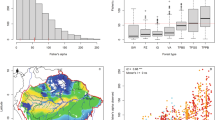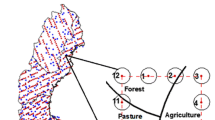Abstract
In order to map the spatial distribution of twenty tree species groups over Europe at 1 km × 1 km resolution, the ICP-Forest Level-I plot data were extended with the National Forest Inventory (NFI) plot data of eighteen countries. The NFI grids have a much smaller spacing than the ICP grid. In areas with NFI plot data, the proportions of the land area covered by the tree species were mapped by compositional kriging. Outside these areas, these proportions were mapped with a multinomial multiple logistic regression model. A soil map, a biogeographical map and bioindicators derived from temperature and precipitation data were used as predictors. Both methods ensure that the predicted proportions are in the interval [0,1] and sum to 1. The regression predictions were iteratively scaled to the National Forest Inventory statistics and the Forest map of Europe. The predicted proportions for the twenty tree species were validated by the Bhattacharryya distance between predicted and observed proportions at 230 plot data separated from the calibration data. Besides, the map with the predicted dominant species was validated by computing the error matrix. The median Bhattacharryya distance in the subarea with NFI plot data was 1.712, whereas in the subarea with ICP-Level-I data, this was 2.131. The scaling did not significantly decrease the Bhattacharryya distance. The estimated overall accuracy of this map was 43%. In areas with NFI plot data, overall accuracy was 57%, outside these areas 33%. This gain was mainly attributable to the much denser plot data, less to the prediction method.






Similar content being viewed by others
References
Bhattacharryya A (1943) On a measure of divergence between two statistical populations defined by their probability distributions. Bull Calcutta Math Soc 35:99–109
Bohn U, Gollub G, Hettwer C (2000) Map of the natural vegetation of Europe. Federal Agency for Nature Conservation, Bonn
Diggle PJ, Ribeiro PJ Jr (2007) Model-based geostatistics. Springer series in statistics. Springer, New York
EEA (2006) European forest types, categories and types for sustainable forest management reporting and policy. EEA Technical report, vol 9/2006
EEA (2007) Environmentally compatible bio-energy potential from European forests. European Environmental Agency
FAO (1992) The digitized soil map of the world—notes. World Soil Resources Report, vol 67 (2–7), Release 1.1. Rome
FAO (2007) State of the world’s forests 2007. Food and Agricultural Organization of the United Nations, Rome
Hasenauer HL (ed) (2006) Sustainable forest management. Growth models for Europe. Springer, Berlin
Hidalgo PJ, Marín JM, Quijada J, Moreira JM (2008) A spatial distribution model of cork oak (Quercus suber) in southwestern Spain: a suitable tool for reforestation. For Ecol Manag 255:25–34
Hijmans RJ, Cameron SE, Parra JL, Jones PG, Jarvis A (2005) Very high resolution interpolated climate surfaces for global land areas. Int J Climatol 25:1965–1978
Hosmer DW, Lemeshow S (2000) Applied logistic regression, 2nd edn. Wiley, New York
Kuhlmann T, Verhoog D, Verkerk H, Lindner M, Kaae B, Hasler B, Nielsen TS, Caspersen HO, Jansson T (2008) Land use policy scenarios in six target sectors. In: Helming K, Wiggering H (eds) SENSOR report series, vol 2008/3. ZALF, Germany
McCullagh P, Nelder JA (1989) Generalized linear models. Chapman and Hall, London
MCPFE Liaison Unit Warsaw, UNECE, FAO (2007) State of Europe’s forests 2007, the MCPFE report on sustainable forest management in Europe
Nabuurs GJ, Masera O, Andrasko K, Benitez-Ponce P, Boer R, Dutschke M, Elsiddig E, Ford-Robertson J, Frumhoff P, Karjalainen T, Krankina O, Kurz WA, Matsumoto M, Oyhantcabal W, Ravindranath NH, Sanchez MJS, Zhang X (2007) Forestry. In: Metz B, Davidson OR, Bosch PR, Dave R, Meyer LA (eds) Climate change 2007: mitigation. Contribution of working group III to the fourth assessment report of the intergovernmental panel on climate change. Cambridge University Press, Cambridge, United Kingdom and New York, NY, USA
Päivinen R, van Brusselen J, Schuck A (2009) The growing stock of European forests using remote sensing and forest inventory data. Forestry 82:479–490
Payne RW, Murray DA, Harding SA, Baird DB, Soutar DM (2007) GenStat for windows (10th Edition) introduction. VSN International, Hemel Hempstead
Pearman PB, Randin CF, Broennimann O, Vittoz P, van der Knaap WO, Engler R, Lay GL, Zimmermann NE, Guisan A (2008) Prediction of plant species distributions across six millennia. Ecol Lett 11(4):357–369
Pearson RG, Dawson TP (2003) Predicting the impacts of climate change on the distribution of species: are bioclimatic envelope models useful? Glob Ecol Biogeogr 12:361–371
Roekaerts M (2002) The biogeographical regions map of Europe. Basic principles of its creation and overview of its development
Schelhaas MJ, Schuck A, Varis S, Zudin S (2003) Database on forest disturbances in Europe (DFDE)—technical description
Schelhaas MJ, Eggers J, Lindner M, Nabuurs GJ, Pussinen A, Päivinen R, Schuck A, Verkerk PJ, van der Werf DC, Zudin S (2007) Model documentation for the European forest information scenario model (EFISCEN 3.1)
Schuck A, Päivinen R, Häme T, van Brusselen J, Kennedy P, Folving S (2003) Compilation of a European forest map from Portugal to the Ural mountains based on earth observation data and forest statistics. For Policy Econ 5(2):187–202
Stehman SV (1997) Selecting and interpreting measures of thematic classification accuracy. Remote Sens Environ 62:77–89
Sykes MT, Prentice IC, Cramer W (1996) A bioclimatic model for the potential distributions of north European tree species under present and future climates. J Biogeogr 23:203–233
Thuiller W, Vayreda J, Pino J, Sabate S, Lavorel S, Gracia C (2003) Large-scale environmental correlates of forest tree distributions in Catalonia (NE Spain). Glob Ecol Biogeogr 12:313–325
Tröltzsch K, van Brusselen J, Schuck A (2009) Spatial occurrence of major tree species groups in Europe derived from multiple data sources. For Ecol Manag 257(1):294–302
UN-ECE (2005) European forest sector outlook study, main report. ECE/TIM/SP/20. United Nations, Geneva
Verkerk PJ, Lindner M, Zanchi G, Zudin S (2011) Assessing impacts of intensified biomass removal on deadwood in European forests. Ecol Indic 11:27–35
Walvoort DJ, de Gruijter JJ (2001) Compositional kriging: a spatial interpolation method for compositional data. Math Geol 33:951–966
Webster R, Oliver MA (2007) Geostatistics for environmental scientists, 2nd edn. Wiley, Chichester
Acknowledgments
This project was carried out within the framework of European FP5 projects CARBO-Europe IP and EFORWOOD IP. We are greatly indebted to the Forest Focus programme and the National Forest Inventory institute’s correspondents. NFI plot data were received from Jacques Rondeux and Martine Waterinckx, Belgium; Juro Cavlovic, Croatia; Veiko Aderman, Estonia; Kari Korhonen, Finland; Thierry Bélouard, France; Heino Polley, Germany; Marino Vignoli, Remo Bertani, Giorgio Dalmasso and Maurizio Teobaldelli, Italy; Andrius Kuliesis, Lithuania; Wim Daamen and Henny Schoonderwoerd, Netherlands; Stein Tomter, Norway; Susanna Barreiro and Margarida Tomé, Portugal; Olivier Bouriaud, Romania; Vladimir Seben, Slovak Republic; Gal Kusar, Slovenia; J. Villanueva and Antoni Trasobar, Spain; Göran Kempe, Sweden; Bill Mason and Shona Cameron, United Kingdom; Igor Buksha, Ukraine. Finally, we like to thank an anonymous reviewer for his expert comments on the statistics, and the suggestion to use Bhattacharryya distance for validation.
Author information
Authors and Affiliations
Corresponding author
Additional information
Communicated by J. Müller.
This article originates from the context of the EFORWOOD final conference, 23–24 September 2009, Uppsala, Sweden. EFORWOOD—Sustainability Impact Assessment of Forestry-wood Chains. The project was supported by the European Commission.
Electronic supplementary material
Below is the link to the electronic supplementary material.
Rights and permissions
About this article
Cite this article
Brus, D.J., Hengeveld, G.M., Walvoort, D.J.J. et al. Statistical mapping of tree species over Europe. Eur J Forest Res 131, 145–157 (2012). https://doi.org/10.1007/s10342-011-0513-5
Received:
Revised:
Accepted:
Published:
Issue Date:
DOI: https://doi.org/10.1007/s10342-011-0513-5




